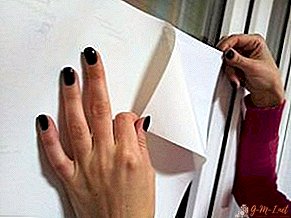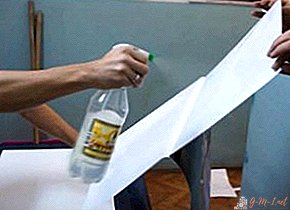 During prolonged use, the cabinet may lose its attractive appearance, but remain strong and reliable. Therefore, owners often do not want to part with it. Many in a given period, there is a desire to make changes to the interior, change the style, add colors and moods while making a minimum of effort and investing a little money. One way to quickly realize these tasks is to change the appearance of the cabinet by pasting it with a self-adhesive film.
During prolonged use, the cabinet may lose its attractive appearance, but remain strong and reliable. Therefore, owners often do not want to part with it. Many in a given period, there is a desire to make changes to the interior, change the style, add colors and moods while making a minimum of effort and investing a little money. One way to quickly realize these tasks is to change the appearance of the cabinet by pasting it with a self-adhesive film.
How to choose a film for the cabinet
 Self-adhesive film can be bought at hardware or construction stores, as well as ordered online. The main parameters that you need to pay attention to when choosing:
Self-adhesive film can be bought at hardware or construction stores, as well as ordered online. The main parameters that you need to pay attention to when choosing:
- Roll width: 45 cm, 67.5 cm and 90 cm. To calculate the required number of films, measure the width of all parts of the cabinet, and to the widest, add 10 cm to the ends (5 + 5 on each side). We measure the height of each part + 10 cm on the doors and determine the length.
- Surface type: glossy - for darkened rooms, matte - for rooms with bright lighting, easy to clean - for the kitchen and bathroom, as well as mirror, transparent, holographic, stained glass.
- Color: solid, with a pattern - for children, imitation of natural materials, fabrics, ceramics, photo wallpaper - for the implementation of any design decisions.
- Protective layer: from damage - for the children's room, from temperature changes, high humidity - for the kitchen and bathroom, from burnout - in direct sunlight.
REFERENCE! For a cabinet measuring 120x200x60 (width * height * depth), you need a film with a width of 67.5 cm (60 + 10 = 70) and a length of (200 * 4) + (10 * 2) = 8.20 m.
How to glue a cupboard with self-adhesive film
The process of pasting furniture begins with the preparation of its surface.
Surface preparation
Before starting work, inspect the cabinet surface for the following defects and repair them:
- Cracks, pits, chips should be smoothed with putty on the tree with a rubber spatula, cleaned with sandpaper of the smallest fraction (zero).
- Clean the dirt with any detergent and degrease with alcohol.
- Apply a furniture primer for adhesion to the uncoated surface. After drying, sandpaper.
IMPORTANT! If possible, it is necessary to remove the doors and lay them on a horizontal surface, unscrew the handles and hinges.
Now that the surface is ready, you should cut the self-adhesive film into pieces of the right size (on the back of the film there is a marking with 1 square cm cells) and proceed to gluing the cabinet in one of two ways.
ATTENTION!If you are gluing the film for the first time, take a small piece and try to glue it on a similar surface in order to understand how gluing occurs, what are the speed and quality of adhesion.
Dry way
Suitable for small surfaces:
- Separate the film from the substrate by 5-10 cm.

- Apply the sticky edge to the base and rub it with a dry cloth or plastic wallpaper spatula.
- Gradually, peeling off the lower layer in small segments, we continue to firmly press the film to the surface. We level it from the middle to the edges and try to prevent the formation of air bubbles and creases of the film.
If there are a lot of bubbles, the film has shifted or wrinkles have formed on the surface, you should not worry - you need to peel off a small area and repeat again.
Wet way
It is used when covering large areas. Work Stages:
- Turn the film over with the adhesive side up.
- Remove the backing completely.

- Using the spray gun with the finest spray, apply a soap solution to the glue (mix 10 ml of dishwashing detergent with 1 liter of water).
- We lay the film with the sticky side on the surface to be glued and level it from the middle to the edges, expelling air and liquid.
- Leave to dry for 48 hours.
ATTENTION!12-20 hours after gluing, walk again with a roller on the surface.
Possible problems in the process of using self-adhesive film
Small errors in the process of work can easily be fixed by improvised means:
- We pierce air bubbles on the film surface with a thin needle or cut it with a clerical knife. Wipe with a soft rag or plastic spatula.
- Fill the dents that have appeared with PVA glue using a syringe. Level with a soft roller.
- In rounded places and on bends, make small cuts with a knife and stick in the right direction.
- Use a hair dryer at maximum power to easily bend the film at the corners and firmly adhere to the edge.
Do not be afraid! Glue with confidence! Everything can be fixed. Pasting a cabinet with self-adhesive film is much easier than making a car's glass tinted.



Leave Your Comment